The AMD Radeon R9 Fury X Review: Aiming For the Top
by Ryan Smith on July 2, 2015 11:15 AM ESTMiddle Earth: Shadow of Mordor
Our next benchmark is Monolith’s popular open-world action game, Middle Earth: Shadow of Mordor. One of our current-gen console multiplatform titles, Shadow of Mordor is plenty punishing on its own, and at Ultra settings it absolutely devours VRAM, showcasing the knock-on effect of current-gen consoles have on VRAM requirements.
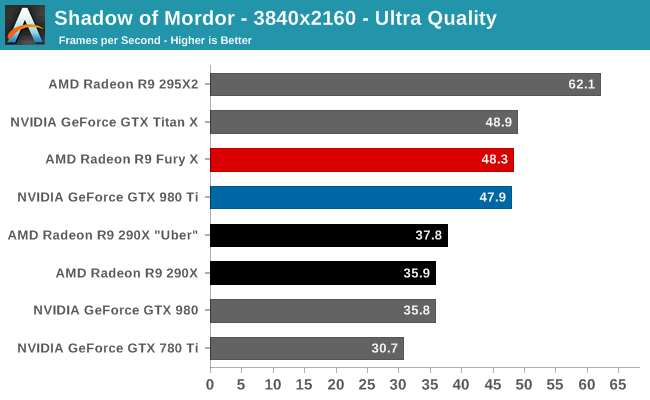
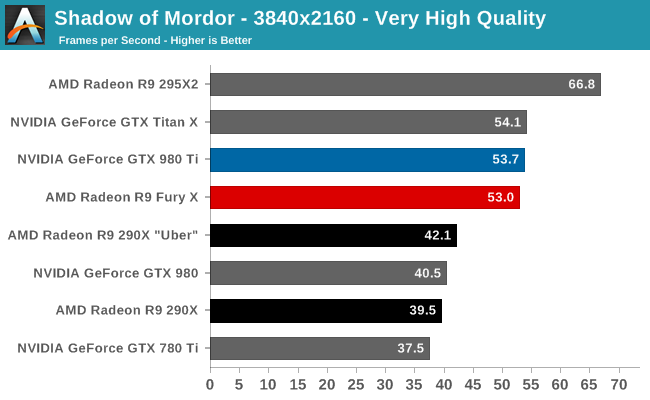
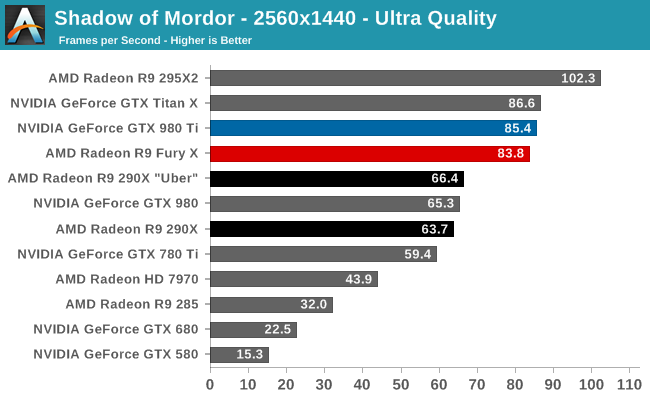
With Shadow of Mordor things finally start looking up for AMD, as the R9 Fury X scores its first win. Okay, it’s more of a tie than a win, but it’s farther than the R9 Fury X has made it so far.
At 4K with Ultra settings the R9 Fury X manages an average of 48.3fps, a virtual tie with the GTX 980 Ti and its 47.9fps. Dropping down to Very High quality does see AMD pull back just a bit, but with a difference between the two cards of just 0.7fps, it’s hardly worth worrying about. Even 2560 looks good for AMD here, trailing the GTX 980 Ti by just over 1fps, at an average framerate of over 80fps. Overall the R9 Fury X delivers 98% to 101% of the performance of the GTX 980 Ti, more or less tying the direct competitor to AMD’s latest card.
Meanwhile compared to the R9 290X, the R9 Fury X doesn’t see quite the same gains. Performance is a fairly consistent 26-28% ahead of the R9 290X, less than what we’ve seen elsewhere. Earlier we discussed how the R9 Fury X’s performance gains will depend on which part of the GPU is getting stressed the most; tasks that stress the shaders show the most gains, and tasks that stress geometry or the ROPs potentially show the lowest gains. In the case of SoM, I believe we’re seeing at least a partial case of being geometry/ROP influenced.

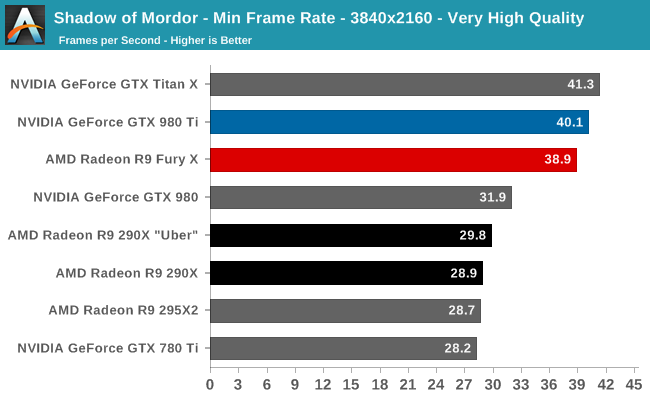
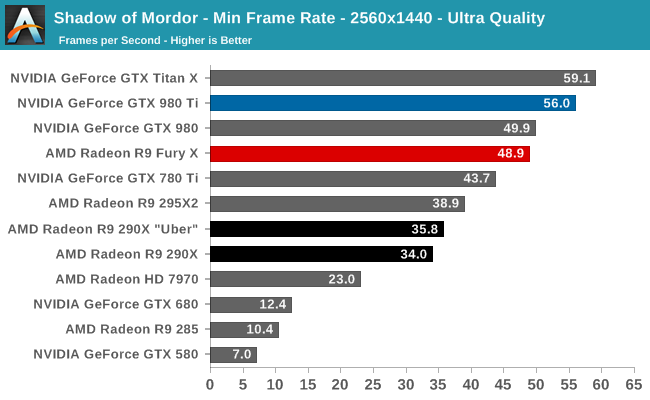
Unfortunately for AMD, the minimum framerate situation isn’t quite as good as the averages. These framerates aren’t bad – the R9 Fury X is always over 30fps – but even accounting for the higher variability of minimum framerates, they’re trailing the GTX 980 Ti by 13-15% with Ultra quality settings. Interestingly at 4K with Very High quality settings the minimum framerate gap is just 3%, in which case what we are most likely seeing is the impact of running Ultra settings with only 4GB of VRAM. The 4GB cards don’t get punished too much for it, but for R9 Fury X and its 4GB of HBM, it is beginning to crack under the pressure of what is admittedly one of our more VRAM-demanding games.










458 Comments
View All Comments
chizow - Thursday, July 2, 2015 - link
What about geometry Ryan? ROPs are often used interchangeably with Geometry/Set-up engine, there is definitely something going on with Fury X at lower resolutions, in instances where SP performance is no problem, it just can't draw/fill pixels fast enough and performs VERY similarly to previous gen or weaker cards (290X/390X and 980). TechReport actually has quite a few theoreticals that show this, where their pixel fill is way behind GM200 and much closer to Hawaii/GM204.extide - Thursday, July 2, 2015 - link
Yeah my bet is on Geometry. Check out the Synthetics page. It own the Pixel and Texel fillrate tests, but loses on the Tessellation test which has a large dependency on geometry. nVidia has also been historically very strong with geometry.CajunArson - Thursday, July 2, 2015 - link
Thanks for the review! While the conclusions aren't really any different than all the other reputable review sites on the Interwebs, you were very thorough and brought an interesting perspective to the table too. Better late than never!NikosD - Thursday, July 2, 2015 - link
You must use the latest nightly build of LAV filters, in order to be able to use the 4K H.264 DXVA decoder of AMD cards.All previous builds fall back to SW mode.
tynopik - Thursday, July 2, 2015 - link
"today’s launch of the Fiji GPU"andychow - Thursday, July 2, 2015 - link
Best review ever. Worth the wait. Get sick more often!tynopik - Thursday, July 2, 2015 - link
pg 2 - compression taking palcelimitedaccess - Thursday, July 2, 2015 - link
Ryan, regarding Mantle performance back in the R9 285 review (http://www.anandtech.com/show/8460/amd-radeon-r9-2... you wrote that AMD stated the issue with performance regression was that developers had not yet optimized for Tonga's newer architecture. While here you state that the performance regression is due to AMD having not optimized on the driver side. What is the actual case? What is the actual weighting given these three categories? -Hardware Driver
API
Software/Game
What I'm wondering is if we make an assumption that upcoming low level APIs will have similar behavior as Mantle what will happen going forward as more GPU architectures are introduced and newer games are introduced? If the onus shifts especially heavily towards the software side it it seems more realistic in practice that developers will have much more narrower scope in which optimize for.
I'm wondering if Anandtech could possibly look more indept into this issue as to how it pertains to the move towards low level APIs used in the future as it could have large implications in terms of the software/hardware support relationship going forward.
Ryan Smith - Thursday, July 2, 2015 - link
"What is the actual case? What is the actual weighting given these three categories? -"Right now the ball appears to be solidly in AMD's court. They are taking responsibility for the poor performance of certain Mantle titles on R9 Fury X.
As it stands I hesitate to read into this too much for DX12/Vulkan. Those are going to be finalized, widely supported APIs, unlike Mantle which has gone from production to retirement in the span of just over a year.
limitedaccess - Thursday, July 2, 2015 - link
Thanks for the response. I guess we will see more for certain as time moves on.My concern is if lower level APIs require more architecture specific optimizations and the burden is shifted to developers in practice that will cause some rather "interesting" implications.
Also what would be of interest is how much of reviewers test suites will still look at DX11 performance as a possible fallback should this become a possible issue.